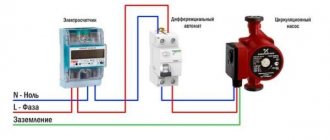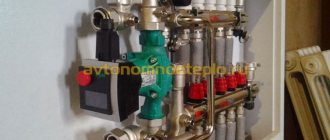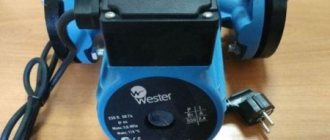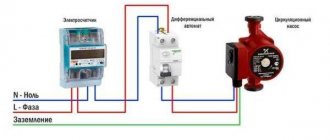Home / DHW
Back
Published: December 13, 2019
Reading time: 4 min
0
2652
In rooms with a long hot water supply pipeline, circulation pumps are used. They are installed in a separate circuit.
The DHW circulation pump makes it possible for water to flow at the required temperature immediately after opening the tap.
- 1 Design 1.1 Glanded rotor pump
- 1.2 With wet rotor
- 4.1 First launch
Why do you need a DHW pump?
The DHW circulation pump is designed to create pressure and constant circulation of water in domestic water supply systems.
After opening the tap, you have to wait a long time for the water to become hot, and the further the water supply point is located from the DHW input, the more time this requires. The pressure in the system does not always meet even the minimum requirements, preventing you from washing properly. Circulation pumps for domestic hot water are installed for the following purposes:
- Ensure stable pressure in the system - for this, hot water is diverted into a special buffer tank, after which it is supplied under pressure to water supply points.
- Ensure instant supply of hot water - the circulation pump for hot water supply is connected to a closed pipeline. Water is constantly in motion. Thanks to circulation, the cooled liquid mixes with the heated one. As a result, immediately after opening the tap, hot water is supplied to the consumer.
The parameters of the domestic water supply make it necessary to install hot water supply in both private and apartment buildings.
Circulation pump for hot water supply: what is it used for and how does it work
You already understand that having installed a hot water pump, you will not wait until cold liquid flows from the tap. The only thing that is not entirely clear is the operating principle of this pump. It is simple and consists of constructing a closed circuit through which hot water constantly circulates. That is, a ring along which water moves endlessly and is periodically heated to a given temperature. A faucet can be installed or a mixer connected anywhere in this ring.
Anticipating your next question, I will say that hot water does not enter this circuit through a heating device that uses fuel to heat the water. This circuit is powered from the heating boiler through a special heat exchanger called an indirect heating boiler - the water here is heated by the heating system. In fact, a battery (coil) is mounted inside such a boiler, upon contact with which the water heats up. This is not a instantaneous water heater - it is a storage boiler that has at least five connection pipes. Two of them are used for connecting to heating, two for circulating hot water (supply and return, so to speak) and one for supplying cold water to the tank.
Recirculation pump for hot water photo
If we describe the operating cycle of such a unit, it looks like this. When the tap on the mixer is closed, the water moves in a circle thanks to the circulation pump and is heated by the coil to the maximum temperature limit. As soon as you open the mixer, water flows out - at the same time, fresh cold water enters the indirect heating tank from the water supply, which is immediately heated from the coil. In general, the same thing happens here as in a conventional electric storage water heater, only instead of a heating element it uses a coil.
Main characteristics
Hot water pumps must provide the specified circulation mode. To achieve this, all devices have certain parameters:
- Operating pressure . This is an indicator that determines the pressure in the pipeline.
- Performance. A value that determines the amount of water that the pump pumps per unit of time.
- Power. This is an indicator that determines the maximum force that can be applied to the shaft of the device.
- Supply voltage . There are pumps that operate on 380 or 220 VAC. In addition, there are low-voltage models (12.24 or 36 V), which are safer to use.
- Construction type . Many models have differences in the rotor design. They provide their advantages, but also have disadvantages.
- Purpose. There are pumps for hot water supply or for heating systems.
Pump parameters are its main indicators that determine the user’s choice. Purchasing a pump without familiarizing yourself with its technical characteristics is extremely risky. It is necessary to ensure full compliance with the system requirements and pump parameters in order to obtain the expected effect from its operation.
You should not choose a model “for growth”, with a large margin in all respects. The pump will only consume excess electricity and make noticeable noise, without improving the circulation in any way.
Boiler with two outlets
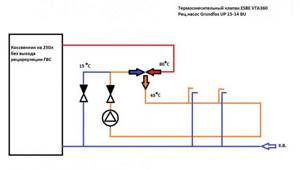
Circulation pump for hot water supply - from an indirect heating boiler without outlet for recirculation
To obtain a stable temperature in the DHW circulation circuit, a three-way thermostatic mixer is used here. To lower the temperature of the water from the primary circuit (at the boiler outlet), he mixes water from the cold water supply into it; it also feeds the boiler, compensating for the consumption of hot water.
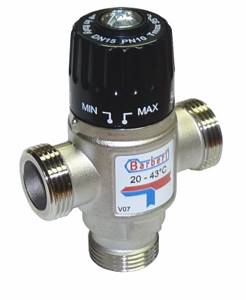
Mixing unit with thermostatic head
It’s interesting: the high temperature in the boiler tank is useful because it disinfects it, preventing the growth of bacteria and the appearance of a specific unpleasant odor in the water.
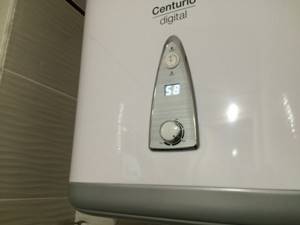
The optimal temperature for heating water with a boiler is 55-75 degrees
How does a circulation pump work in a hot water supply system?
The operating principle of the DHW circulation pump is almost identical to that used in heating systems. The purpose of the installation is to increase and stabilize the missing water supply pressure.
Circulation pumps in domestic hot water systems of private residential buildings operate as follows:
- A closed hot water system is installed, consisting of: a storage tank, shut-off and control valves, pumping equipment and a circuit connected to water distribution points.
- Hot water is drawn into the container. The pump creates the necessary pressure, forcing a certain amount of water to constantly circulate in the pipeline circuit.
- When the tap is opened, the consumer immediately receives hot water under pressure, sufficient to take a shower, quickly draw a bath, etc.
Most models of pumping equipment designed for hot water supply have electric motors based on a “wet rotor”. All moving parts are completely immersed in water. The “wet” design has many advantages: no need for maintenance, quiet operation, low energy costs.
Along with this, there is a danger of dry running. The coolant plays the role of a lubricant. Without lubrication, bearings instantly fail.
Circulation pumps used in hot water supply systems of multi-storey residential buildings are often called booster pumps, since their task is mainly to create sufficient pressure in the water supply system.
Preparing to install equipment
Before you begin installing the pump, carefully read the operating algorithm. The first step is to prepare for installation. To do this, purchase split-type threads and a filter for deep cleaning. Also, before installing the equipment, you need to prepare a check valve. It stabilizes the operation of the heating system. To work you will also need:
- a set of keys;
- a set of large and small flat screwdrivers;
- pliers;
- a pipe whose diameter will be equal to the diameter of the riser;
- fittings
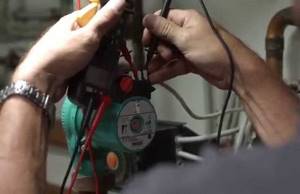
Installing an auxiliary pump
It is worth deciding in advance on the installation location. Modern units can be installed not only on the water supply pipe, but also on the return pipeline. If you plan to install the device on a section of pipe between the return and direct radiator-type wiring, then before doing so you will need to check the ability of the unit to withstand a powerful pressure of hot liquid.
It is also worth remembering that in buildings where the premises are equipped with “warm floors”, the injection device is placed at the hot water supply point. In this way, it will be possible to eliminate airiness in the pipes.
Device connection technique – what to connect to what?
Residents of the house will not receive high-quality heating if the pump is not connected correctly. When connecting the device to the power grid of natural circulation systems, an automatic fuse is used. To install the latter, you should choose a place at a distance of at least 70 cm from the main boiler.
In forced circulation systems, the pump will start working after the thermal relay is turned on. In order to ensure simultaneous operation of the built-in and additional pump, the second device will need to be connected to a relay or routed in parallel to the first device.
In electric-type boilers, circulation devices should be connected directly to the boiler. In this case, the pump will only operate when the liquid is heated.
The cleaning filter must be installed in front of the pump housing. A valve screwed into the upper part of the bypass makes it possible to ventilate the pipeline, removing any air that has accumulated there.
DIY installation
It is important to know how to properly install a heating pump. You also need to know which pump to install in the heating system. Each unit comes with instructions that you will study carefully to ensure you can complete the installation yourself correctly. All liquid is drained from the system, part of the pipe is cut off in the place where the pump is to be installed.
In many cases, an old system that has accumulated dirt and rust will need to be cleaned. It is inconvenient to do this through the drain valve due to the small cross-section of the hole, so use the cut point. A hose is connected to one side through which water is fed under pressure, and on the other side the water flows out.
A bypass is installed at the pump site. This is necessary in case of device failure or power outage. The coolant will then flow through the main line, which is manually opened. It is better to install an automatic one instead of a conventional ball valve, which reacts to changes in pressure in the system.
On the bypass, two ball valves are placed on each side of the pump to turn off the water for maintenance or, if necessary, remove it. At the top of the bypass line, install the air release valve vertically. To install the pump, it is recommended to use the following sequence of actions:
- Drain the water and clean the heating system.
- For a system that has been in use for a long time, it is recommended to flush it a couple of times, filling it with water and then draining it.
- Install the purchased pump into the designated location according to the plan, following the principle of energy management.
- After installation, fill the device with liquid (water).
- Check the operation of the heating system. In case of any errors, their strict correction is necessary.
- Remove accumulated air from the system using the central screw. Outgoing water is a sign that the operation was carried out correctly.
- Turn on the built-in pump after filling it with water. When connecting equipment to the network, it is recommended to use an automatic fuse with a special flag.
The fuse has an additional function as a switch. To install an additional pump in the system, please note that it turns on only after a relay signal. To synchronize the operation of both pumps, you need to connect the second device to the relay or use an alternative parallel connection.
Installation features
There is one important point, without which the installation of the circulation pump will require rework: it is necessary to rotate the rotor so that it is directed horizontally. The second point is the direction of flow. There is an arrow on the body indicating which direction the coolant should flow. This is how you turn the unit so that the direction of movement of the coolant is “in the direction of the arrow”.
The pump itself can be installed both horizontally and vertically, just when selecting a model, make sure that it can work in both positions. And one more thing: with a vertical arrangement, the power (pressure created) drops by about 30%. This must be taken into account when choosing a model.
Rules for installation in a heating system
Regardless of the type of design of the circulation pump, it is installed on a pipeline or shut-off valve using American union nuts. This makes it possible to quickly dismantle in case of repair or replacement of the device.
There are the following recommendations for installing a circulation pump:
The unit can be embedded in any part of the pipeline - horizontal, vertical or inclined
The main thing is to maintain the horizontal orientation of the rotor axis (the head should never look down or up). It is very important that the plastic container with electrical contacts is placed on top of the case, otherwise it will be flooded with water during an accident. In addition, this will significantly complicate the maintenance of the device.
This is quite simple to do by unscrewing the screws securing the box and turning it in the desired direction. The arrow on the pump body indicates the direction of coolant flow, which is important to observe. To simplify maintenance and repair of the device, it is recommended to equip it with shut-off valves on both sides. This will allow you to avoid draining water from the circuit during dismantling.

With this installation scheme for the heating pump, the entire load from its mass falls on 1 or 2 ball valves: their number depends on the spatial orientation of the device. Therefore, it is better not to save money, but to purchase high-quality shut-off valves, the body of which has good mechanical strength.
Difficulties in installing an additional pump in the heating system

Having found out whether it is possible to install an additional pump for heating, you need to choose its location correctly
The difficulty lies not in calculating the optimal power, which is also important, but in the consistency of the device’s operation with the main pump
There are several options that will require the installation of additional elements. A special place among them is occupied by the installation of additional heating at home. In practice, this can be implemented in two ways:
- Constructing a separate line with radiators and all the necessary piping. For this you will need an additional boiler;
- Modernization of the existing system - arrangement of a new heating circuit connected to the main one. Then you will definitely need to install an additional heating radiator or several.
The second option is the most practical, since there is no need to purchase additional equipment and components. But then an additional problem arises - asynchronous operation of the pump impellers. Even with the same number of revolutions, this will lead to uneven movement of water in the pipes, which is the first cause of water hammer.
Installation of hydraulic arrow
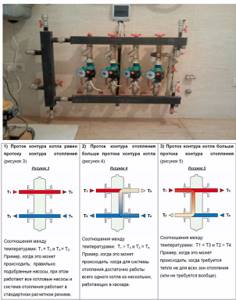
Hydraulic gun with pumps
The way out of this situation is a fundamentally new scheme for installing an additional pump in the heating system. Its innovation lies in the installation of a hydraulic arrow.
This device compensates for pressure drops in a certain area of the system, thereby normalizing the heating operation.
This device normalizes the pressure in the main and return pipes. In additional heating of an apartment, its installation is not necessary, since the increase in the circuit may be insignificant. But if the volume of water in the system increases by more than 20%, means should be provided to normalize circulation and pressure. To install an additional circulation pump in a heating system together with a hydraulic compensator, the following rules should be followed:
- Location - as close as possible to the entrance of the return pipe to the boiler;
- Installation of shut-off valves for each pump circuit;
- Installation of mesh filters.
If it is impossible to install the hydraulic arrow correctly, you can make its simplest analogue. To do this, a through jumper is made after the connection point of the additional pump to the heating system. Its optimal length should be 300-400 mm. This circulation ring will be able to partially balance possible hydraulic shocks.
Kinds
There are many types of pumps. They differ from each other in their technical characteristics and purpose. There are pumps:
- Drainage. Used to pump excess ground (soil) water.
- Submersible. This pump must be submerged in water to operate properly.
- Self-priming (or surface) . The suction pipe is lowered into the water, and the pump itself is on the surface.
- Increasing pressure (or increasing) . Used to increase pressure in the system, ensures normal operation of plumbing fixtures, washing machines and dishwashers.
- Industrial. Unlike the household model, the industrial model has increased power, durability, and is able to work in difficult conditions. The cost of industrial models is significantly higher than that of household ones.
Installation diagrams
Depending on the number of connection points and the length of the pipes, the method of connecting the circulation pump and pipe routing is selected:
- serial connection with one circuit;
- parallel connection with the collector.
In the first case, all water intake points are connected in series and in one circuit. This is beneficial if you can easily combine the bathrooms and kitchen with one water pipe without unnecessary material costs and a fairly short route. There is only one feature that concerns the pressure pump rather than the circulation pump. If several water intake points are open at the same time, the pressure in each of them will be divided equally. Alternatively, this can be solved by installing a gearbox on each tap and choosing a more powerful pump.

The simplest installation diagram for a recirculation pump
Parallel connection solves the problem with pressure and water distribution using a manifold group and compact placement of gearboxes. In this case, recirculation pumps must be installed in each individual circuit or one more efficient pump must be selected for all groups at once. Such wiring is necessary if there are several bathrooms in the house, spaced far from each other and from the kitchen, or when, with a serial connection, the total length of the route becomes too long.
When and how it is advisable to use a hot water circulation pump
Such a scheme for hot water supply in a house is not always advisable - in short, in small houses with 3-5 rooms it is unjustified. For such cases, a conventional double-circuit heating boiler is suitable - the short length of the hot water supply lines will not make you wait long for heated water to flow from the tap. Another thing is large houses with several bathrooms and a complex heating system. This is where a hot water supply system with a circulation pump shows itself one hundred percent. What problems are solved in this way?
- First of all, there is always hot water in the tap - there is not a second of waiting until you get heated water.
- The second point is the increase in pressure in the system. In large houses, as a rule, pipes stretch over a long distance - the result of the long length of pipes is a weakening of the pressure in the system, which is compensated by the recirculation pump for hot water.
These are the main tasks of the hot water supply ring circuit. As a bonus, it provides a couple more benefits.
- Saving water - that is, cold water does not drain into the sewer. The one that flows from the tap while you wait for hot water to appear in a standard system using a double-circuit boiler or a conventional boiler.
Saving fuel resources.
The same coolant that heats your home is used to heat hot water. Naturally, this saving occurs only in winter - in principle, in summer it also works economically, but this is not visible at first glance. Savings in summer occur due to the storage tank, rather than direct heating of water in the water supply. Pump for hot water supply photo Among other things, the pump itself allows you to save resources. He can do this solely due to the ability to program the on time. Let's just say that hot water is not used at night, which means there is no need to operate the circulation pump for hot water. Therefore, you need to program it so that it turns on half an hour before you go to the bathroom. What are the savings here? When circulation stops, the water in the circuit quickly heats up and the heat exchanger stops taking heat from the heating circuit. In turn, the coolant in it cools less, as a result of which less fuel will be needed to heat it to a given temperature.
Pros and cons of using a heating pump
Just a couple of decades ago, in the private sector, houses were equipped with gravity-type heating.
A wood stove or gas boiler was used as a heat source. There was only one area of application left for large circulation devices - centralized heating networks. Today, manufacturers of heating equipment offer smaller units that have the following advantages:
- The speed of movement of the coolant has increased. The heat generated by the boiler quickly enters the radiators. Due to this, the process of warming up the premises was significantly accelerated.
- The higher the movement speed, the higher the throughput of the pipes. This means that an identical volume of heat can be delivered to rooms using a pipe with a smaller diameter.
- Water heating schemes have undergone significant changes. The highway can be laid with the slightest slope. Also, the complexity and length of the line can be anything. The basic rule is the rational choice of a heating pump based on the required power.
- With the help of a household circulation device, it became possible to organize heated floors in the house, as well as an effective closed-type heating system.
- It became possible to hide the entire heating communication line passing through the rooms, which does not always go well with the design of the room. Options for laying pipes behind suspended ceilings, in walls or under floor coverings are quite common.
The disadvantages of pumping systems include the dependence of operation on the supply of electricity and its consumption by the pumping apparatus during the heating season.
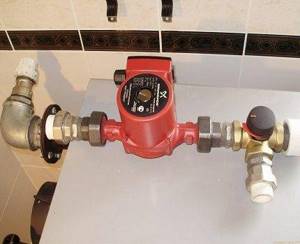
The leading company Grundfos, engaged in the development of heating equipment, has released innovative models of Alpfa2 circulation pumps, capable of changing performance based on the needs of the heating system, which allows saving on electricity consumption
Therefore, if the area is often deprived of power supply, it would be advisable to install a device to provide uninterrupted power. The second drawback is not critical and can be eliminated by correctly selecting the power and model of the circulation pump.
How to choose a pump for hot water supply
First you need to understand the difference between a heating circulation pump and a domestic hot water pump. It consists of three points. First of all, this is the ability to withstand a certain coolant temperature. If heating circulation pumps are capable of working with coolant heated to almost 100 degrees, then DHW pumps can only withstand heating up to 65 degrees. Secondly, heating pumps are made of cast iron, and domestic hot water pumps are made of brass. And thirdly, pumps for hot water supply at home have less power reserve.
At first glance, it may seem that a regular heating circulation pump can be installed in the hot water supply system - unfortunately, this is not the case. These two types of pumps are not interchangeable, which must be taken into account first of all when approaching the issue of choosing a circulation pump for a hot water supply system.
In addition, when choosing this equipment, it is necessary to take into account the following points.
- Specifications. This is a calculation - a correlation with the necessary indicators. What is taken into account here is the loading of the system (so to speak, water collection) and the required flow force. The system load is determined based on the number of installed plumbing fixtures, the number of users and the intensity of use. Water consumption is calculated based on the average value per point (on average it is about 150-180 l/hour), and the flow strength is calculated based on the length of the pipelines. On average, in order to push water through a 10 m long pipe, a pump must create a pressure of 0.6 m of water column. So if the characteristics of the pump indicate that it lifts water by 4 m, then it can be used with a pipeline length of 60 m.
- Functionality. This is the ability to program the DHW pump. The cheapest option is a pump with a mechanical on timer. The most expensive and, according to many users, convenient is a pump with an electronic programmer. Modern models allow the pump to independently select the optimal operating mode. It not only automatically adjusts to the intensity of hot water use, but also independently switches to night mode and, accordingly, back to day mode.
Criterias of choice
The choice of equipment depends on several factors, but the basic one is the thermal power of the facility. An accurate calculation can only be performed by a specialized organization. But for an approximate calculation, a simple ratio of power and heating area is used for central regions, for example, in Moscow: for 10 m2 - the required power is 1 kW.
The next criterion is the connection diagram, which depends on the possibility of subscriber input of the electrical network into the house, voltage and number of phases. For a small boiler of 6 kW (object up to 60 m2), you can connect to a single-phase 220V network, while larger power boilers will require three-phase networks (380 V). Many manufacturers produce units with the ability to connect to both three-phase and single-phase networks.
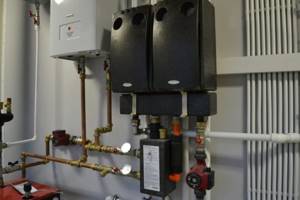
When choosing an electric boiler with a pump, you need to take into account the thermal power
The next factor is that the security system must cope with threats such as low or high pressure of network water, overheating of the heating element or freezing of water. EC control is selected from three options: manual, digital or programmable. It is advisable to choose a unit with power control. In budget models it is stepped, and in devices with programmers it is smooth.
In this case, based on data from pressure and temperature sensors, the software allows you to automatically set the mode. When using a multi-tariff meter, the maximum load on the boiler will operate from 23:00 to 07:00. Of no small importance is the presence of auxiliary devices complete with the pump and expansion tank: temperature and pressure sensors, fittings and pressure gauges.
Where to buy a circulation pump?
How to make the right choice?
When selecting equipment, it should be taken into account that circulation pumps are of dry and wet type. In the first case, the engine rotor is not in direct contact with the liquid, in the second case it is. For large houses, it is better to choose dry type pumps. They are characterized by good performance, but are very noisy. It is better to install them in a separate room. Wet pumps are great for small spaces because they create minimal noise during operation.
Installing a circulation pump in a domestic hot water system
Installation of the pump in the domestic hot water system must be carried out in accordance with the manufacturer’s recommendations and existing building codes. Installation work is carried out as follows:
- Installation location of the DHW circulation pump - the module is mounted on the return line. This arrangement prevents air from entering the station - airing leads to a decrease in the performance of the system. For this reason, the pump should be installed exclusively on the return water supply.
- A check valve is installed immediately after the pump and in front of the storage tank. Shut-off valves must be installed before and after the station.
- The connection to the mains is made via a UPS for power supply. After a power outage, the uninterruptible power supply continues to ensure autonomous operation of the equipment for from several hours to a day. (how to choose the right UPS for pumping equipment, read here).
- To distribute pressure evenly, a complex DHW control system is installed, including several distribution manifolds and special pressure reduction valves.
- It is prohibited to start the electric motor at idle speed. After the pump has been installed in the hot water supply system, the water circuit is filled, a test run is performed and the functionality is checked.
- Maintenance – wet rotor pumps have a simple design, so they do not require inspection or repair during their entire service life. The filter will need to be cleaned and replaced from time to time. The frequency of maintenance of a pump with a dry rotor is once every 2 years. During the work, the lubricant is replaced and the housing is cleaned.
Insufficient pressure in the central water supply system necessitates the installation of a circulation pump for hot water in apartment buildings and private buildings, regardless of the heated area.
Equipment power calculation
After the thermal circuit has been calculated, the number of circuits, the length of the network has been established, and a point for placing the source has been selected, we begin to select the EC parameters. In the retail network they are sold with a power from 2 to 70 kW, and devices with a thermal performance of more than 50 kW are used for industrial facilities.
Power calculations are entrusted to a special organization, they use online calculators or are calculated using the formula: Wк=(SxWsp)/10, where:
Wк – thermal power of the unit, kW; S – total heated area, m2; Wsp – specific power per 1 m2 of area, depends on the climatic region, set: for the southern regions 1.0, for the central ones – 1.1 – 1.15, for the northern ones – 1.2.
Calculation example: Climatic region – center of Russia. Heating area – 160 m2. Thermal power: (160∙1.1)/10=17.6≈18 kW.
This calculation is quite suitable for a single-circuit heat supply scheme, that is, only for heating. In double-circuit schemes with hot water supply, it will be necessary to carry out additional calculations for the needs of hot water supply, taking into account SNIP standards for hot water consumption and the number of service users.
The next calculation that will be required in electric heating is the calculation of the electrical network for connecting the unit. An incorrectly selected cable will overheat greatly during operation, creating a fire hazard. For an approximate calculation, you can take a simple ratio - a current of 1 A will require a cross section of 1 mm2. Calculation example for determining the cross-sectional area of an electric boiler cable:
Power – 6 kW; The network is single-phase 220V. Calculation formula for conductor cross-sectional area mm2: S= Wк/(U∙I). U – 220 V, I – 8 A. Calculation: S= 6000/(8∙220)=3.41 mm2
This is a fairly approximate calculation; you will also need to take into account the cable material and its length.
All work on the installation of electrical equipment must be carried out in full compliance with the requirements of industry norms and standards, as well as safety rules:
- It is prohibited to install the unit in close proximity to a water supply or water source.
- During installation, observe the recommended construction distances between the unit and structures.
- A mandatory connection of the EC to the ground loop is required.
- The wall-mounted device is installed on a wall made of non-combustible materials.
- Laying power cables under heating or water pipes is prohibited. In places where utility networks may intersect, a protective metal casing is installed.
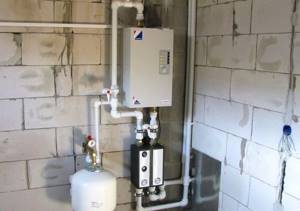
An electric boiler with a pump must be installed in full compliance with all safety regulations
How to make the first launch?
The first start-up, as a rule, is made after the device is fully connected, the entire line is assembled and filled with water.
It is prohibited by the instructions to turn on the pump dry. This is fraught with breakdown and failure, as well as refusal of the warranty workshop to carry out repairs.
Before starting, you need to make sure that the system is completely ready for operation . Most designs automatically remove air when a special screw is turned.
You need to unscrew it half a turn (or more) and wait a few seconds until the air comes out and water flows out. For other pumps it is necessary to install a special air venting element (Maevsky valve).
Management methods
There is no need for continuous operation of the pumps, since the system is able to maintain water pressure for some time. Typically, the criterion is that the water in the system cools down to 50°, after which circulation needs to be started. There are two standard methods for controlling device operation :
By timer
For pipes with normal thermal insulation, it takes about 15-20 minutes for the flow temperature to drop to a critical value.
Therefore, a conventional time relay is often used, which is set to a certain value . It is adjusted in working order, determining the most convenient break in pump operation.
By sensor
Based on determining water temperature. For this, a temperature sensor (thermistor) is used, which gives a command to automatically start the pump when the flow temperature drops to a preset value.
This control method is considered more reliable because it is based on determining the state of the water rather than on a time average.
The most common types of breakdowns and how to fix them
The most common type of breakdown is the impeller stopping. The device hums but does not work properly. To solve the problem, you need to turn off the circulation, drain the water, disassemble the device and move the impeller. Typically, the cause is the adhesion of small particles or the entry of foreign objects into the flow.
The second most common type of malfunction is overheating . It occurs due to lack of lubrication on the bearings or due to the regular entry of air into the system. The problem can be solved if the rotating parts are well lubricated and all connections are reliably sealed.
Everything you need to know about hot water is presented in this section of the site.


